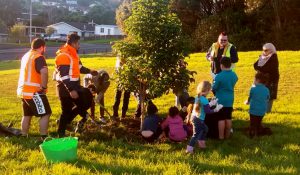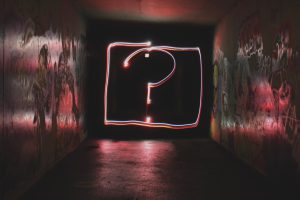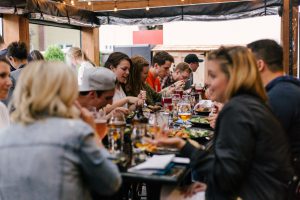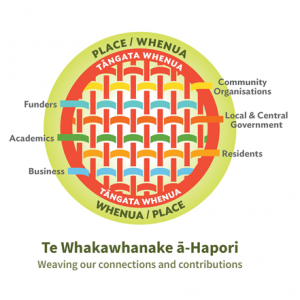Community engagement tips
Reach out to a diversity of people, in fun creative ways to have lots of conversations
All communities are different, so community engagement approaches need to be tailored for each context and culture – the why and the who strongly influences your how. Your why or purpose should determine both who you are engaging with and what/how things are set up. What do you want to learn, share or achieve as a result of the interaction? Once you have your clear engagement purpose in mind, it’s important to do some background work to get prepared.
There is no one size fits all when it comes to engagement. Depending on your role, you might use a variety of methods to engage with diverse people and groups: for example, one on one or (small or large) group meetings, phone conversations, and online communications. Some will be formal meetings that may need preparation beforehand, e.g. developing agendas, making a presentation or organising an event.
Others will be smaller in scale, requiring a different style and level of formality, e.g. a scheduled café meeting or a brief conversation at a community hui to build relationships, exchange information and get to know what’s important to each party. Some may involve working with other partners in joint community engagement activities and could involve the creation of an engagement plan.
For getting started as a new community group or in a new place or role, here are some useful community engagement tips:
Make time to understand the local scene, who’s here and how things happen
- Do some googling
- Chat with neighbours, colleagues, others in the community you may know
- Attend community hui/workshops/meetings to get a sense of local people, place, and context Who are mana whenua? What about tangata whenua, taura here, mātāwaka and tauiwi relationships?
- Which key community leaders, organisations and networks will be useful to have on your radar?
Be positive, proactive and observant
Take every opportunity to meet new people and organisations. A friendly smile goes a long way! Also look for cues in terms of formality, style, tactics and different ways of engaging by watching and learning from other effective community leaders you meet.
Do what you say you’ll do
If you say you’ll follow up by phone next week or that you’ll forward information, do it, or let people know if something’s no longer possible. This shows respect and helps builds trust and confidence.
Relationship building between tāngata whenua and tāngata Tiriti
Relationship building between tāngata whenua and tāngata Tiriti (all others who have come here) organisations, groups and communities is a core component of CLD in Aotearoa. Here are some resources to support you in developing these relationships.
Here’s a resource on developing relationships with Tangata Whenua. Many of the key messages, for example in Atawhai Tibble’s 5 Wais of Māori Engagement (this can be read fully fleshed out in context here), also apply to engaging with communities more broadly.
Ideas for how to reach out
Community hui (meetings) are necessary but not enough to engage people around growing local visions and inspiring local action. Only some parts of the community will show up to meetings, for all sorts of reasons. So, we need to get creative about going to where people are and having lots of conversations. From those conversations, we can shape doable small actions to get started.
Once you are clear on your why (e.g. you know more about this community’s history, hopes and dreams) and have some ideas about what you want to ask, here are some creative examples about how to reach out, that have worked for others:
- Knock on doors street by street and have one-on-one conversations
- Invite people out into a suitable place on their street for a cuppa and a chat
- Use an artificial Christmas tree in a shopping area for people to add their wishes to and as a conversation starter
- Use PhotoVoice or a similar tool to engage people whose voices don’t always get heard
- Engage children in classroom discussion with art materials, props, stationery…
- Encourage the children to go home and talk to their parents about the same questions
- Invite people with disabilities, new migrants, older people and other groups commonly left out to help you design new ways to engage with them and their networks
- Plan a fun community event like a community dinner or family fun day and get people drawing, talking and building images of what they would like as part of the event
- Use existing connections to grow connections, e.g. finding out who has links with the local hapū or iwi and who are the appropriate people to start connections with
- Use a large map of the area as a focus point and discussion opener and ask Where do you live? before going into deeper conversation
Make sure you are inviting participation and sharing information about how people can be involved, not just collecting ideas for ‘someone else’ to action. People might decide to do something together straight away, or to share contact details. Otherwise, let them know how to stay connected.
If you are working with children, check out these fun, educational activities for primary and intermediate students on valuing, enjoying, improving and caring for one’s street, neighbourhood and community from the Ranui Massey Back to Back Project: A booklet for teachers and A booklet for students.
What can go wrong?
There are many things that can get in the way of positive community engagement, e.g. lack of time, transport, childcare or interest, people’s busy schedules, lack of experience or information, poor organisation or communication, a history of bad past experiences, leadership styles/attitudes/behaviours and the sheer fatigue of overcommitted people.
The best way to know how things are going and/or to understand why they are not going well is to intentionally and openly ask. You don’t have to be the expert. Rather, you can ask people from the groups you want to be more engaged about what you need to do differently. When inviting feedback and encouraging constructive dialogue around outcomes, barriers, possibilities, you need to be prepared to honestly and openly listen, reflect, clarify and identify potential changes that could be made. And ideally you will work with those same people to co-design and implement a new way forward. You can turn failure into stronger trust and respectful relationships for the future.
The use of images to communicate
PhotoVoice is a process that was developed in 1995 by Caroline Wang to gather information from women living in rural China. It’s an opportunity for community members who aren’t often heard, or find it hard to communicate, to talk about things that are important to them.
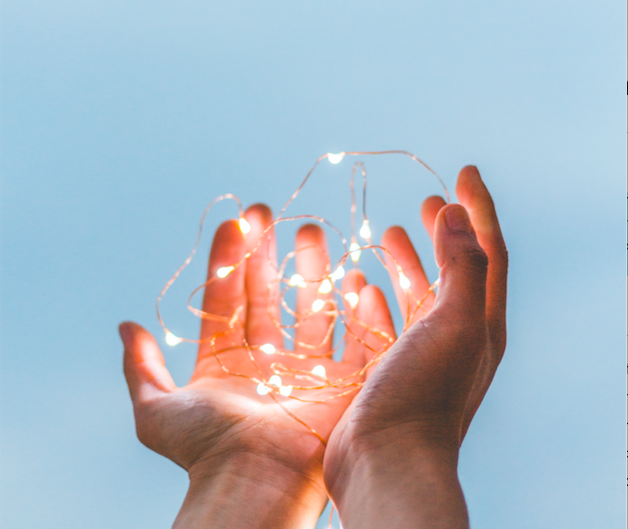
An opportunity for community members who aren’t often heard, or find it hard to communicate, to talk about things that are important to them.
VOICE stands for Voicing Our Individual and Collective Experiences.
Each PhotoVoice project is different, and how it’s facilitated will depend on who you’re planning to connect with, what you’re trying to achieve, and how many people will be in attendance. It will also depend on the individualities of participants and the community itself.
Learn more and visit the PhotoVoice website for more information.
Strategies to build your community
Community change and collaboration is not going to happen overnight. But with planning and methodical action, it’s absolutely achievable.
Initiating discussion is the first step to uncovering a community’s strengths. From here we can learn about how our community can work together, find resources for creative solutions and helps turn people’s energy into action.
These two resources are great places to start:
How to craft powerful questions
Learn by doing
The types of questions we can ask, and the ways in which they’re asked, can have a big impact on how people engage with us and what information is received in return.
Asking well thought out, clear and direct questions is a great way to be more efficient in meetings, gather the information you know that you need, and getting the most from the people who have gathered to share information. If you’ve not done this sort of thing before it can be a challenging exercise, and we recommend that you take some time to work through this helpful worksheet.
If you would like to learn more about engaging your community, be sure to have a look at the page How to get community conversations started.
Active Listening Checklist
Active listening involves paying attention, withholding judgment, reflecting, clarifying, summarising and sharing. Each listening skill requires several techniques or behaviours. Download the PDF resource below to learn more.
How to get community conversations started
What do you need to know and why? Here are a few examples of powerful questions you might choose from or adapt. They are strengths-based and reflect an Appreciative Inquiry approach. They help us clarify our why – purpose or vision, what – actions people have energy for, and how – how people will work to draw on the strengths the community already has.
The kinds of questions you ask can have a big impact on the way people engage with you, the type of information you gather and on the involvement or action that follows. Strengths-based questions bring out community pride and help identify assets for addressing challenges. These questions invite conversations about community issues that need to be addressed, but don’t start by focusing on a problem or on something that’s missing.
Closed questions generally elicit yes/no responses. The more open-ended your question, the more powerful they are in triggering deeper conversations and encouraging people to think more creatively. As a result, new possibilities emerge and often provoke next questions.
We want to begin a conversation and grow a relationship. We want to gather information, but we are also building trust and together exploring possibilities for future engagement.
Examples of powerful questions
Choose a few questions to get community conversations started that are fit for your purpose.
What we already have
- What makes (name of our place) a great place to live, work and play in?
- What do we love about this place e.g. about its history, culture, physical/natural environment, people, facilities, etc?
- What’s happening?
- What matters to people?
- What is working well? And how?
- Who are key people helping make it a great place?
Our future aspirations
- What would make (name of our place) an even better place to live?
- How do we get more of the good stuff?
- What are your hopes and dreams for this place? E.g. if it was the coolest neighbourhood for you and your whānau/family to live, work and play in, what would it look like/be like?
- What needs to change? Why?
Making it happen
- If together we could take action on one thing to strengthen this place/community, what would be most important to you?
- What could we do?
- Two years from now, if we had been successful, what would you see?
- What opportunities do you see?
- What do people have energy for?
How will we do it?
- How would you like to be involved?
- What would you love to be part of?
- What’s important about how we work together?
- What are doable next steps?
- Who else in this space might be interested in helping us?
- How can we draw on what we already have here?
If you’d like to know more about designing your own powerful questions, see this resource on how to design your own powerful questions.
Other useful resources
Use the active listening checklist as a tool to help you or your group review what needs to be in place to have engaging conversations with the people you talk to, and check this tool to help you brainstorm ways to reach out to a diversity of people, in fun creative ways.
Here’s some further information about mapping community assets and strengths and Appreciative Inquiry as a strengths-based approach.
Our Community Readiness Questionnaire
Here are some questions to help you think more deeply about your community context, stories and experiences. This process can help you to think about what’s needed for the full potential of your community to be achieved and what support or actions might be built into your planning and processes to help build community capacity to participate, lead and succeed. Understanding the big picture of a local community – its strengths, challenges and experiences – is important. Individually and collectively, a range of readiness factors will impact on the pace, buy-in and process of locally-led change.
Te Reo resources
Te Reo Resources
Here are some useful resources, created for us, that we’d like to share with you. There are PDFs with karakia, waiata and whakatauki you can use. There are also accompanying sound files for these. Please feel free to use and share them.
We’ve also listed some websites and apps we think are great for learning Te Reo.
Downloadable PDFs
Sound files
Karakia
1. Mauri oho – Karakia timatanga
2. Whiti ora – Karakia timatanga
3. Whakataka te Hau – Karakia timatanga
4. Tukua te wairua kia rere – Karakia timatanga
5. Kia tau ngā manaakitanga – Karakia timatanga or whakamutunga
6. Unuhia – Karakia whakamutunga
7. Kia tau – Karakia whakamutunga
8. Whakapaingia ēnei kai – Karakia mō te kai
9. Kua horahia te kai – Karakia mō te kai
10. Nau mai e ngā hua – Karakia mō te kai
Whakatauki
Celebrating leadership
1. He kotuku rerenga tahi
Celebrating hard work
1. He rā whatiwhati kō
2. Tē tōia, tē haumatia
3. He Manawa tītī
4. Mauri tū, mauri ora
5. Kua hua te marama
How to add a Māori keyboard
See how to add a Māori keyboard and integrate it into Word with English here.
Useful websites and apps
Kupu
With the Kupu app, users simply take a picture. Kupu then uses image recognition to identify what the object is in the picture and provide Te Reo Māori translations for the object(s). Fun and easy to use!
Download here for iPhone users and here for Android users.
Pepeha
Pepeha is a way of introducing yourself in Māori. It tells people who you are by sharing your connections with the people and places that are important to you. Once you have completed your Pepeha you can save it to your device, have it printed for display or as a taonga for yourself or a loved one.
Our engagement with Te Tiriti o Waitangi
Nā tō rourou, nā taku rourou ka ora ai te iwi
With your basket and my basket we will sustain the people
Inspiring Communities is committed to a Treaty honouring Aotearoa where people actively participate in shaping their communities. Te Tiriti o Waitangi is a foundation for sharing power between tāngata whenua and tāngata Tiriti (all others who have come here) to sustain just and vibrant communities.
We champion ‘place’ within the context of Aotearoa and recognise te tino rangatiratanga of hapū as expressed in
He Whakaputanga o te Rangatiratanga o Nu Tireni (the 1835 Declaration of Independence) and affirmed in Te Tiriti o Waitangi. Self-determined processes for whānau/hapū /iwi are at the heart of flourishing wider communities.
As a small, tāngata Tiriti organisation with a national focus, our intentions are aspirational and realistic. Our Treaty commitment is reflected conceptually, structurally and practically. We do this in the following ways:
Conceptually – the framing of ideas which inform our work
We develop CLD theory that is contextualised to Aotearoa and reflects the centrality of tāngata whenua to ‘place.’ We do this through applying a Treaty lens (see below) to our core conceptual work. We acknowledge our position as tāngata Tiriti and engage with Te Ao Māori to shape our work.
Structurally – Māori decision-making power and influence on our work
We are intentional in seeking input and involvement from Māori at strategic and operational levels. As an enabler at the local community level, we actively promote and support positive engagement with whānau/hapū/iwi. Work with tāngata whenua is built on recognition of self-determination.
Practically – the work we undertake and our ways of working
Our work strengthens the capacity of communities to contribute to a Treaty honouring Aotearoa. We are developing our internal capability to work effectively with tāngata whenua.
Applying a Treaty lens
We understand the commitments made in Te Tiriti o Waitangi as being critical to the context of CLD in Aotearoa. Therefore, we apply a Treaty lens to our CLD work. The following questions guide us in this:
- What does the concept/initiative/project look like using a Treaty lens?
- Who is shaping this work and what perspectives does it reflect?
- How is this work grounded in an understanding of tāngata whenua relationships to place?
- How does this work affirm and support te tino rangatiratanga?
Here is a tool for working with Tangata Whenua.
Here are some useful Te Reo resources.
Re-imagining Governance.
There are many practical resources for good governance for community organisations and initiatives. Community Net is one great website to look at for a start.
What does Community-led Governance look like in practice?
Governance will depend on what kind of project or organisation you are, your size, and your core reason for existing. There is a saying “form follows function”, that is, your structures/ways of organising should reflect your purpose and activities. Take time to think about what kind of governance model you might need. No one size fits all! The key questions are:
How and how well is your current governance structure enabling community input into decision making, encouraging collaborative action and decision making? What would you like to change and why?
• What values and culture do you want to embrace in how your CLD governance will work
- How might CLD principles be embedded in what you do and how?
Embedding CLD Principles in governance practice
- Grow from shared local visions: The most important work of governance is to be wise kaitiaki or guardians, enabling the wider community (not just those elected or appointed) to shape dreams and plan activities to enable shared local visions.
• Build from strengths: Governance can empower action-focused, project-based teams to work with their strengths, assets and passions and get on with their work in a nimble, adaptive way – though sometimes things might not always go as planned.
• Work with diverse people and sectors: Governance can take the lead in building movements for collective impact in communities. They can intentionally focus on enabling broad participation and seeking new alliances: making decisions with rather than for people, proactively looking for new collaboration opportunities.
• Grow collaborative local leadership: Governance needs to be about relationships and connections more than hierarchical decision making. Lightweight, flexible, flat governance structures promote high trust and shared decision-making, with diverse leadership. Leadership ‘tables’ in communities need to be linked, not sitting in silos.
• Learn by doing: Being courageous and taking risks is all part of CLD. Along with the wider community, a governance team intentionally learns from the doing at every step. They hold themselves accountable as guardians/kaitiaki of shared values and vision but know there’s a collective responsibility for action and outcomes. They are accountable to the community and other stakeholders and are up for experimenting to see what works, actively adapting to ensure things keep moving forward.
Things we learned that work
When a CLD group or project is just getting started:
• The most important thing is to let your vision, values and culture shape your structure, not the other way around! Aim to apply CLD principles to all that you do. That includes embedding these principles in way you do things and the governance structure you create or evolve over time.
• Get started by doing some things together that people have energy for. Focusing on governance structures too early on can be a bit dull and can dampen community energy for taking action. Make sure you read the mood of those you’re working with – you don’t need to be a formal group or entity to make things happen!
• You might look for an organisation to support you that has shared or similar values. They might be able to awhi your group as things get going, help fund or hold funds for your project, employ team members, provide venues or resources, make connections to funders etc. You might not always need their support, but in the early days it can really help having friends there supporting. Also make sure you have a clear agreement with them about roles, responsibilities and relationships and how you’ll review things, recognising that things may evolve and change with time.
• Think about who needs to be involved in the core guiding or decision making group and what processes you’ll use to make decisions. Given CLD is a relational, trust- based way of working, what decisions can be made by action teams, rather than the governance group? How will you encourage wider community?
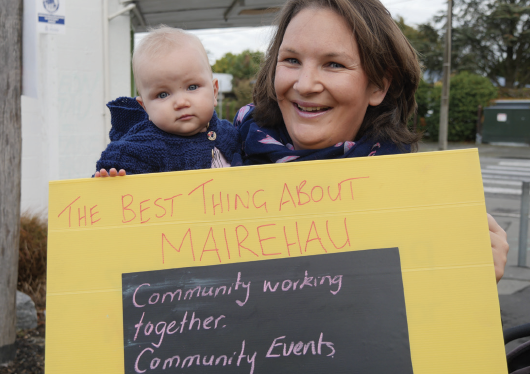
Meetings don’t always have to be closed group or traditional. You could use some of the following ideas for enabling greater community participation in your governance activities.
- Host open community gatherings (get-togethers, afternoon teas, pizza nights, picnics in the park) every 3 or 4 months to bring people together and share what’s happening in the community and with your project. Look for opportunities to actively involve others in the set-up of these so that they bring their networks too. You don’t have to make it look like a meeting. Have some fun, acknowledge and celebrate people doing great things, welcome others to join in ask some powerful questions to get people thinking, create space for people to raise issues or explore their ideas.
- Host community awards nights, where people can share and celebrate stories about projects they’ve been working on, what they’ve learnt and their ideas for ‘what next’. Or community story evenings where mana whenua and others can share the history of this place and special people, events that have shaped it.
- Invite in others from your community or stakeholder networks to be part of an annual reflection and sense-making session to look at what’s happened in the last year and why, and how this should shape next steps. Again, make it light and fun! Why have a meeting when you could have a party?
- Reinvent AGMs as purposeful but more fun, interesting community conversations and celebrations. Reach out to get some new voices, host a community quiz or include ideas-gathering opportunities as part of your AGM events, e.g. what ideas do teenagers in your community have and how could you support them? What can we learn from mana whenua about the history of this place and support their future plans?
- Include planning and engagement activities as part of all your community events and activities during the year. For example, at your local Easter Egg Hunt you might set up a wishing tree so children and adults can share what they value in their place or what changes they’d like to see. Or you could informally interview people with your smart-phone, asking them the same questions, or take photos of people holding a chalk board with their ideas or response to a question.
Going deeper – four key leadership functions
From our work in communities, we can see there are at least four core elements for any governance/ kaitiaki group or organisation using a CLD approach: oversight, foresight, insight, and a strong team culture.
These ideas are adapted with a community-led development lens from Chait, Ryan and Taylor’s work on Governance as Leadership (2005) and from others like Trower (The Practitioner’s Guide to Governance as Leadership: Building High Performing Nonprofit Boards, 2013) who have built on their insights.
Oversight: good stewardship of things currently happening, and any associated decisions about policies, communications, systems, finances, employment practices, organisational culture, legal obligations, risks, problems and performance. This is traditionally the main focus of governance. It should be part of what governance focuses on, but not the only part, especially in a CLD context.
Foresight: being good strategic thinkers, – looking ahead to where we want to head and how to get there effectively, including what relationships will be required. Considering our vision, values, mission and key strategic priorities and then learning, adapting and innovating as risks and opportunities are identified. Many groups do this through some kind of regular cycle of strategic discussion and planning.
In CLD we need a loose plan but not a grand or fixed strategic plan, because things emerge and evolve in many unexpected and diverse ways. It’s essential to ensure capacity, resource and mandates are in place to proactively adapt as needed.
Insight: making spaces for generative thinking where we tap into the knowledge of the people around the governance table (and beyond it) and data to take a fresh look at opportunities and challenges for making the biggest impact. Given change is the only constant, there’s a need to be aware of the changing environment and what this means for our vision and next steps. Building in sense making time to both look for past patterns and new ways of approaching things are key roles for CLD governance groups.
A strong team culture: this is our opportunity to be the change we want to see in our communities. We can model values-based ways of working together that grow trust, capability and confidence for diverse ideas and people/groups to connect, succeed, learn, fail, adapt and celebrate what CLD is making possible.

